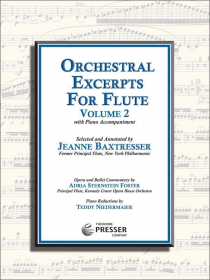Edmund-Davies, P :: The 28 Day Warm Up Book
-
ComposerEdmund-Davies, P
-
InstrumentationFlute Alone
-
PublisherCarolyn Nussbaum Music []
-
Orchestrationfl
-
Includes CD or Audio DownloadNo
-
ClassificationMethods, Etudes & Studies
-
GenreUndefined
-
Review
The daily exercises cover four areas: sonority, fingers, articulation and intervals. I felt compelled to write about my experience with these exercises because it is a lesson in humility. With several decades of professional playing under my belt, I took a look at some of the pages and thought “how simplistic, I don’t need that stuff”. But playing them, I realized that they were quite challenging. So I got to work. And they sound nice! My family particularly likes to hear me practice Articulaton no. 7.
A number of exercises I find useful for piccolo practice. Intervals no. 2 is not only good for intervals, but makes a great intonation study if played with a drone from a tuner or computer. (How I wish I had a live tambura player to assist me :-)). Articulation no 6, with its combination of repeated and moving notes, is especially good for controlling the sometimes tricky middle register of the piccolo.
The section on fingers I find very practical. He points out that scales are all well and good, but they don’t really train the fingers to lift and close with swift independence. The exercises, some of which are based on Taffanel & Gaubert, reinforce this idea. Because its familiarity makes for easy memorization, I am a great adapter of T&G myself, and am always happy to learn other approaches.
-
Review SourceHelen Bledsoe
-
Youtube (final characters)MgfvFT-BPgk
Written by flautist Paul Edmund-Davies 'for all flautists... eventually!' this book covers four key areas of study: Sonority, Fingers, Articulation, and Intervals. It tackles these issues in a logical, musical, and interesting way, and can be used to 'tone' everything up or as part of a dedicated regime. Musicians who follow this four-week course from start to finish will notice a very positive improvement in their overall ability, agility, accuracy, security and control.
From Paul Edmund-Davies:
'This book came about as a result of a limited conviction of, and at certain times despair in, my own technique ‘system’. Having been impressed on numerous occasions with the seemingly flawless and almost irritatingly fluent control of others, I had over a long period of time wondered why I appeared to struggle with what ultimately were some very basic issues (yes, being a musician is fuelled by a sinister cocktail of paranoia and self doubt!). Of course there are numerous books available covering all aspects of playing, but there appear to be few available that highlight key elements in a compact, logical, compelling and musically stimulating way. When I was studying, it seemed to be that one week I was concentrating on articulation, the next week scales, the following week something else and so on, which in many ways is what it should be like, in order to embrace all of the complexities of learning an instrument.'
-
ComposerEdmund-Davies, P
-
InstrumentationFlute Alone
-
PublisherCarolyn Nussbaum Music []
-
Orchestrationfl
-
Includes CD or Audio DownloadNo
-
ClassificationMethods, Etudes & Studies
-
GenreUndefined
-
Review
The daily exercises cover four areas: sonority, fingers, articulation and intervals. I felt compelled to write about my experience with these exercises because it is a lesson in humility. With several decades of professional playing under my belt, I took a look at some of the pages and thought “how simplistic, I don’t need that stuff”. But playing them, I realized that they were quite challenging. So I got to work. And they sound nice! My family particularly likes to hear me practice Articulaton no. 7.
A number of exercises I find useful for piccolo practice. Intervals no. 2 is not only good for intervals, but makes a great intonation study if played with a drone from a tuner or computer. (How I wish I had a live tambura player to assist me :-)). Articulation no 6, with its combination of repeated and moving notes, is especially good for controlling the sometimes tricky middle register of the piccolo.
The section on fingers I find very practical. He points out that scales are all well and good, but they don’t really train the fingers to lift and close with swift independence. The exercises, some of which are based on Taffanel & Gaubert, reinforce this idea. Because its familiarity makes for easy memorization, I am a great adapter of T&G myself, and am always happy to learn other approaches.
-
Review SourceHelen Bledsoe
-
Youtube (final characters)MgfvFT-BPgk
All online purchases greater than $200 (before tax) are eligible for free shipping within the US. (Some Exceptions apply.) Online purchases over $200 being shipped to locations outside the United States do not qualify for free shipping.
Items returned from a purchase utilizing the free shipping offer that brings the original invoice under $200 will result in the original shipping charge being re-applied.
Once shipment has reached its destination according to the shipping carrier tracking information selected, Carolyn Nussbaum Music Company is no longer responsible for the package.
*Please note that some items may vary slightly from the pictures on our website as manufacturers make changes to their products.
We accept Visa, Mastercard, and Discover for online purchases up to $10,000.
You may also assemble your order online and pay offline using the "Offline Payment" payment method during the checkout process. In this case, once you submit your order, you will be contacted via phone or email for payment details before your order is processed. For offline orders we accept personal checks, bank checks, money orders, or travelers checks, with other legal tender acceptable only per arrangement.

















![Bernold, P :: La prononciation [Pronunciation]](http://www.flute4u.com/var/images/product/262.280/D009790043100003.jpg)




